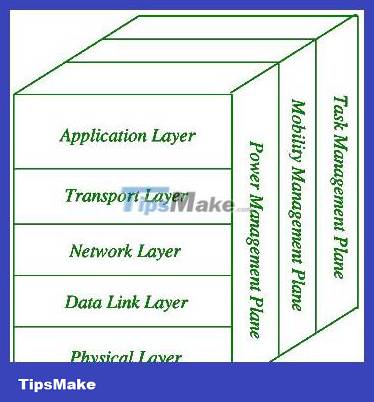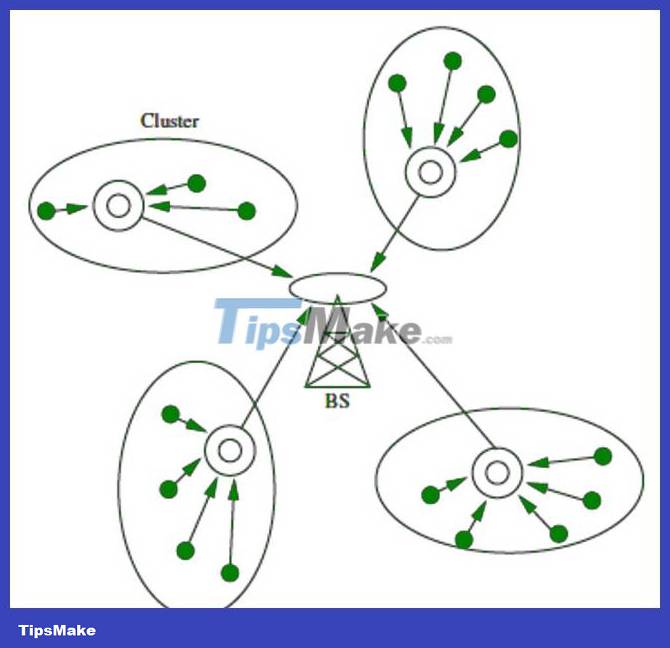What is Sensor Network Architecture?
Sensor network architecture is used in Wireless Sensor Network (WSN). It can be used in various places such as schools, hospitals, buildings, roads, etc. for various applications such as disaster management, security management, crisis management, etc. …
Types of architecture in WSN
There are 2 types of architecture used in WSN: Layered Network Architecture and Clustered Architecture. They are explained as follows.
1. Layered network architecture
The layered network architecture uses several hundred sensor nodes and a powerful base station. Network nodes are organized into concentric layers.
It consists of 5 layers and 3 cross layers.
The 5 layers are:
- Application layer
- Transport class
- Network layer
- Data link layer
- Physics class
Cross layers include:
- Power Management Plane
- Mobility Management Plane (Mobility Management Plane)
- Task Management Plane

The advantage of using a layered network architecture is that each node is only involved in short-distance, low-power transmission to neighboring nodes, due to lower power consumption compared to other sensor network architectures. It is scalable and more fault tolerant.
2. Clustered network architecture
In clustered network architecture, sensor nodes automatically combine into groups called clusters. It is based on Leach Protocol using clusters. Leach Protocol stands for Low Energy Adaptive Clustering Hierarchy.
Leach Protocol Properties:
- It is a 2-tier hierarchical cluster architecture.
- It is a distributed algorithm that organizes sensor nodes into multiple groups called clusters.
- The cluster head nodes in each cluster are formed automatically creating a time-division multiple access (TDMA) schedule.
- It uses a concept called energy-efficient Data Fusion.

Clustered network architecture is a very useful sensor network because of the property of Data Fusion. Inside each cluster, each node communicates with the cluster head to collect information. All the clusters formed share the collected information with the base station. Cluster formation and cluster head selection within each cluster is an independent and autonomous distributed process.
You should read it
- Test of computer architecture P5
- 3D ultrasound fingerprint sensor under Qualcomm's first screen in the world
- How to calibrate sensors on Android
- Test about computer architecture P4
- Computer network models
- What is tire pressure sensor? Should I install it in a car?
- The Wormhole attack in wireless sensor networks
- Sony developed a camera sensor 'like the human eye'
May be interested
- The emergence of application delivery technology is controlled by software and what it can do for your network
 the flexibility of cloud computing has prompted it to seek opportunities to replicate its flexibility in infrastructure and operation. automation initiatives have optimized many layers of stack-based computer data structures, but application delivery services are still a problem when network staff feel cut off by the architecture is not uniform.
the flexibility of cloud computing has prompted it to seek opportunities to replicate its flexibility in infrastructure and operation. automation initiatives have optimized many layers of stack-based computer data structures, but application delivery services are still a problem when network staff feel cut off by the architecture is not uniform. - Everything you need to know about AMD Zen 5
 amd released the zen 4 architecture in 2022, powering the ryzen 7000 and 8000 chips, with game-changing power, especially in the 7900x3d and 7800x3d processors. however, there are rumors that amd will soon launch its successor, the zen 5 architecture.
amd released the zen 4 architecture in 2022, powering the ryzen 7000 and 8000 chips, with game-changing power, especially in the 7900x3d and 7800x3d processors. however, there are rumors that amd will soon launch its successor, the zen 5 architecture. - What is LiDAR sensor? What effect is LiDAR on iPhone 12 Pro, iPhone 12 Pro Max?
 lidar sensor (short for light detection and ranging) will help enhance the camera experience on the iphone 12 pro and iphone 12 pro max. so what is lidar?
lidar sensor (short for light detection and ranging) will help enhance the camera experience on the iphone 12 pro and iphone 12 pro max. so what is lidar? - How to Clean an Abs Sensor
 your vehicle's anti-lock braking system (abs) keeps the tires from locking up when you brake, helping you stay safe on the road. if you notice the abs light lit up on your dashboard, that means something is interfering with the sensor....
your vehicle's anti-lock braking system (abs) keeps the tires from locking up when you brake, helping you stay safe on the road. if you notice the abs light lit up on your dashboard, that means something is interfering with the sensor.... - Huawei is 'copying' both European architecture?
 now, with the new headquarters built in dongguan, china, the technology company is aiming for a plan to 'get inspired' from something even more 'macro': the entire european architecture. europe.
now, with the new headquarters built in dongguan, china, the technology company is aiming for a plan to 'get inspired' from something even more 'macro': the entire european architecture. europe. - How to customize force sensor gestures on AirPods Pro
 this article explains how to customize the functions that are assigned to airpods pro gestures. remember that ios devices need to be running ios 13.2 to support airpods pro.
this article explains how to customize the functions that are assigned to airpods pro gestures. remember that ios devices need to be running ios 13.2 to support airpods pro. - Test about P3 computer architecture
 to check your knowledge, the following article network administrator will send you a very interesting set of questions on this topic. hope they will help you accumulate more useful knowledge.
to check your knowledge, the following article network administrator will send you a very interesting set of questions on this topic. hope they will help you accumulate more useful knowledge. - How to use fingerprint sensor Galaxy S8 to navigate the notification bar
 the notification bar is a frequently used area on the galaxy s8, and we can fully adjust it via the sensor area on the device.
the notification bar is a frequently used area on the galaxy s8, and we can fully adjust it via the sensor area on the device. - It is already possible to integrate an optical fingerprint sensor under the LCD screen, increasing the chances of bringing this technology to low-cost phones
 3m has successfully developed a method that allows the integration of an optical fingerprint sensor into the lcd panel, making it possible to use it on cheaper products, reaching more users. .
3m has successfully developed a method that allows the integration of an optical fingerprint sensor into the lcd panel, making it possible to use it on cheaper products, reaching more users. . - How to fix the unresponsive fingerprint sensor on the phone
 the unresponsive fingerprint sensor on the phone makes users feel uncomfortable when using the password input method to open the lock screen. so what if your phone also has this error?
the unresponsive fingerprint sensor on the phone makes users feel uncomfortable when using the password input method to open the lock screen. so what if your phone also has this error?










 Difference between WAN port and LAN port
Difference between WAN port and LAN port What are the benefits of segmenting an Ethernet network?
What are the benefits of segmenting an Ethernet network? 8 tips to secure wifi wireless networks for businesses and families
8 tips to secure wifi wireless networks for businesses and families 6 best network inventory tools and software of 2023
6 best network inventory tools and software of 2023 Which is better DHCP or static IP?
Which is better DHCP or static IP? Top 10 good, cheap, genuine, best Wifi Routers in 2023
Top 10 good, cheap, genuine, best Wifi Routers in 2023